Throughout the history of mythology, probably no single weapon is as well known as the thunder god Thor’s hammer Mjölnir. In Greek mythology Zeus has lightning bolts, and Hercules has a giant club. However, both pale in comparison to the mightiest weapon found in Norse mythology.
Not merely a weapon, Mjölnir can also be used to resurrect animals. This is at least the case with Thor’s two goats Tanngrisnir and Tanngnjóstr after they have been eaten. It was forged by dwarves, it was once stolen by the jötun Thrym and it followed Thor on numerous adventures.
In this post I will share both what makes it so unique, dive into the symbolism of Mjölnir and explore all the times it pops up in ancient Norse myths.
Name and Etymology
Mjölnir was in Old Norse written Mjǫllnir. The meaning isn’t entirely clear. However, mjǫll is Old Norse for white as new snow, or something close to it. There are some attempts to find the meaning for it based on similar ancient Slavic and Russian words, but personally I believe it’s derived from the Old Norse mjǫll. That doesn’t mean I think the hammer was understood to be named ‘Snow white’. Rather something along the lines of ‘that which makes it snow white’, as in it creates the white lightning.
However, there is another possibility if it is based on the Old Norse mala, which means to grind. Coincidentally in old Norwegian, as well as modern Swedish, mjöl means flour. Flour obviously being the product of grain, having been grinded down. It might just be a coincidence, or hint at something pointing at the name being associated with grinding something, or someone down. However, there is little in the myths pointing to Mjölnir grinding anything, instead it is a crusher of skulls.
The Creation of Mjölnir
There is a pretty funny story about how Mjölnir was created. As is so often the case in Norse mythology, Loki plays a big part in it. The story is found in the Prose Edda, Skáldskaparmál chapter 35, Treasures of the Gods.
In the story, we hear how Loki once, as a prank, cut off all of Thor’s wife Sifs’ lovely golden hair. Upon finding out who was behind it, he threatened to break every bone in his body unless Loki could restore Sif’s hair. Wanting to avoid the true wrath of Thor, Loki sought the help of dwarf brothers known as the Sons of Ivaldi. They were renowned master craftsmen and smiths and there was nothing they could not create.
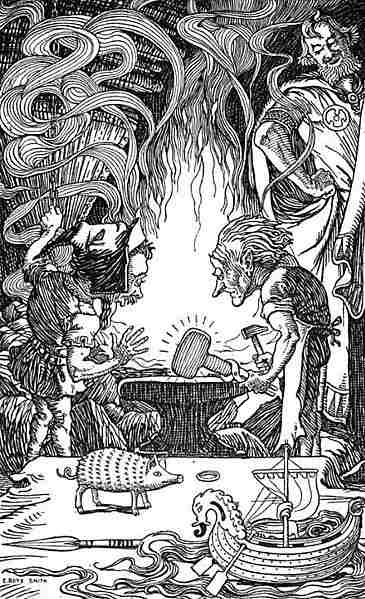
The Sons of Ivaldi truly did create some wonderful artifacts. Not only did they craft hair for Sif from pure gold, that would attach like it was her normal hair, but they also created the ship Skidbladnir and the spear Gungnir.
Loki’s big mouth gets him into trouble
On his way back to Asgard after having picked up the wonderful items, Loki meets another dwarf named Brokkr. He is the brother of Sindri, another master smith and craftsman, possibly the best among the dwarfs. However, Loki, feeling pretty sure of himself boasts that Sindri could never have created gifts as wonderful as the ones the Sons of Ivaldi had. Angered, Brokkr wages his head that Sindri can and will craft superior artifacts, a bet Loki happily takes.
Brokkr returns to his brother’s forge, and then helps him when Sindri sets out to prove Loki wrong. Loki, in the guise of a gadfly does his best to disturb them. In the end Loki really only managed to interrupt the creation of the hammer, rendering its shaft a little short.
In the end Brokkr sets out for Valhalla with his own treasures he presents to the gods. Among the magnificent gifts Sindri had crafted, is Mjölnir, which is given to Thor. This is how it is described:
“Then he gave the hammer to Thor, and said that Thor might strike as hard as he desired, whatever might be before him, and the hammer would not fail; and if he threw it at anything, it would never miss, and never fly so far as not to return to his hand; and if be desired, he might keep it in his sark, it was so small; but indeed it was a flaw in the hammer that the fore-haft was somewhat short.”
Power and Magical Properties
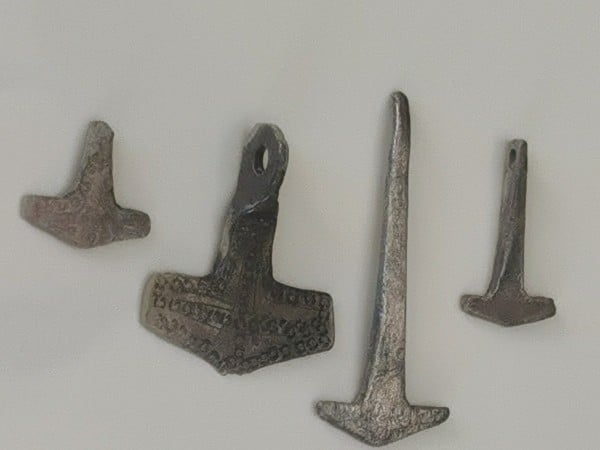
As it was described above, Mjölnir has several powers making it the ultimate weapon. However, it holds even more powers, not originally mentioned by Brokkr. There are especially two things I want to mention, one quite practical, and a second more spiritual.
Using Mjölnir, Thor is able to bring back to life his two goats, after eating them. So when they are out on an adventure, Thor and whoever he is traveling with, can cook and eat the goats. The next morning, Thor will hold the hammer over the pile of bones and hide, bringing the goats back to life.
Another use for Mjölnir is to bless, or consecrate some proceeding, like a marriage or a funeral pyre. This is mentioned several times, and I believe that it might have been a tradition actually performed in the Viking Age as well.
List of Powers and Properties
- It is unbreakable, no matter how hard Thor strikes something
- Thor will never miss when hurling the hammer at someone
- No matter how hard or far he throws it, the hammer returns to his hand
- The size of Mjölnir can be reduced so that Thor can wear it as a pendant
- It can bring animals (and humans?) back to life
- It can be used to bless a marriage or funeral or similar
There is a possibility that it could also create thunder and lightning. If so, it would fit nicely with its name, and Thor being the god of thunder. However, there are few, or no real mentions of this. Instead, there are some round-about mentions of the wheels of Thor’s chariot creating lightning as he rides across the sky. The thunder could very well be emanating from the chariot as well.
Either way, Mjölnir is such a fearsome weapon in the end it will be the thing that finally kills the giant serpent Jörmungand. It is also the weapon of choice when the Aesir asserts their influence over the jötnar. Even if one of the jötun actually manages to steal Mjölnir one time, at least until he pays the ultimate price for it.
Megingjord and the Jarngreiper
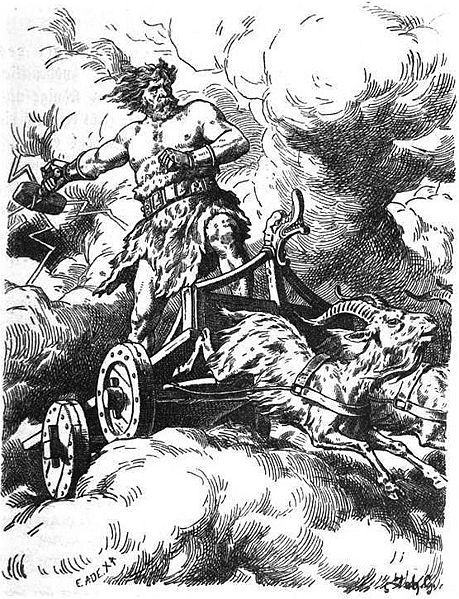
In addition to Mjölnir, Thor has a couple of other enchanted artifacts that go well with his mighty hammer. First he has a belt known as the Megingjord, (girdle of strength) which was a belt that doubled his already considerable strength.
Secondly, he has a pair of iron gloves known as the Járngreipr. The exact power, and need for these isn’t detailed in any of the Poetic Edda poems. In the Gylfaginning part of the Prose Edda however, they are said to be necessary to handle Mjölnir.
“His third treasure that is of so great value is his iron gloves; these he cannot do without when he lays hold of the hammer’s haft.”
It seems plausible that the Jarngreipr are needed to handle Mjölnir, but this is not mentioned anywhere else. Furthermore, wouldn’t the dwarves have given them to Thor along with the hammer?
This might be a sign of how slight variations of stories evolved. Some of the oldest Norse myths can be traced back to the Iron age, preceding the Viking Age. In that time, and in the VIking Age to follow, while they were all pagans, the people of what is today Scandinavia didn’t have a totally uniform culture or religion. Local variations evolved and that might often be the reason for ‘discrepancies’ we see today, having collected all the myths together as a whole.
Mentions and Myths From the Poetic Edda
The most interesting mention of Mjölnir in any of the Norse myths has to be of its creation, described in the Prose Edda. However, it does come up in a number of Poetic Edda myths as well. Often as the instrument of death for some hapless jötun. There are also other instances where Thor uses Mjölnir to bless a ceremony, or bring his goats back to life after having been eaten.
Hymiskvida – Fetching Hymir’s Cauldron
Hymiskvida is thought to have been a late addition to the collection of poems known as the Poetic Edda. The poem was likely written in the first half of the 11th century. It tells the story of when Thor and Tyr went to see Tyr’s father, the jötun Hymir, about a kettle. It also brings Thor face to face with Jormungand, the Midgard serpent and prophesied killer of Thor.
In the story, Thor uses Mjölnir on two different occasions. The first time is when he and the jötun Hymir are out fishing. Thor manages to get Jormungand on the hook, and he strikes him with Mjölnir, however it doesn’t kill him.
This is in stanza 24. in the Hymiskvida
- The venomous serpent quickly up
To the boat did Thor, the bold one, pull;
With his hammer, the loathly hill of hair
Of the brother of Fenrir he struck from above.
The second time Thor lets Mjölnir fly is as he and Tyr are leaving with Hymir’s cauldron. Feeling tricked, or just angry about Thor beating him, Hymir and his kin of jötnar decide to pursue Tyr and Thor.
This is in stanzas 36. and 37 in the Hymiskvida
- They had not gone far when the son of Odin looked back
Once more to see;
From their caves in the east he saw them coming
With Hymir, the throng of the many-headed. - He stood and cast the kettle from his back,
And wielded Mjollnir, the lover of murder;
So he killed all the whales of the waste.
Thrymskvida – Thor the Bearded Bride
In Thrymskvida we get to hear the story of how the jötun Thrym manages to steal Mjolnir. To give it back, the old jötun demands the goddess Freyja’s hand in marriage. She is less than enthusiastic about the idea and the gods have to come up with another plan.
Regarded by many as one of the best written poems in the Poetic Edda, the Thrymskvida is an entertaining story. It doesn’t contain the wealth of mythological references of poems like Vafthruthnirsmál or Grimnismál and as such it is closer to Hymiskvida. However, it portrays the god Thor in a slightly embarrassing situation, having to dress up as a woman. In the masculine warrior culture of the Viking Age, this was likely a funny proposition.
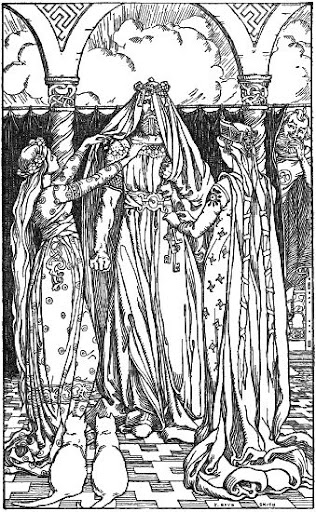
Naturally, things don’t quite go as hoped for Thrym. In the end both he and his whole extended family of jötnar ends up dead for their insolence. This is described at the end of the poem.
30: Then Thrym, the giant’s leader, spoke loudly:
“Bring in the hammer to bless the bride;
Let Mjollnir lie on the maiden’s knees,
So that both of us may be blessed by Vor.”
Hlorrithi’s heart laughed in his chest
When he saw his hard-souled hammer;
First he killed Thrym, the king of the giants,
Then he killed all the giant’s folk.
He also killed the giant’s old sister,
She who had begged for the bridal fee;
She got a blow in place of the money,
And for many rings, the power of the hammer.
And so Othin’s son got his hammer back.
Mjölnir to Bless a Jötun Marriage?
One point I’d like to make is that it does seem strange that the jötun would bring out the hammer in order for the marriage to be blessed. Why would the jötnar care one way or the other about the gods’ customs? Personally I feel this might be some late confusion or addition by whoever wrote down the story centuries later. Certainly it would have been enough just to bring out the hammer, and also, who was there to receive it, on behalf of the Aesir? Either way, Thor got it back, and he killed all the jotnar in attendance.
Lokasenna – The Flyting of Loki
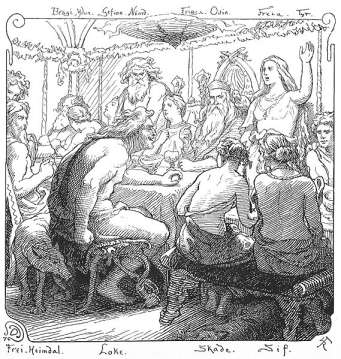
The Lokasenna Poetic Edda poem Lokasenna is set at a great feast at Aegir’s hall. In the poem Loki goes out of his way to insult every god in attendance. The bantering and insults are a little similar to the dialogue between Harbard (Odin) and Thor in Harbardsljöd. They also throw insults back and forth, and from that share some choice observations.
The old tales from Norse mythology aren’t strictly chronological, but the Lokasenna comes somewhere towards the end. Soon after this feast takes place, the gods will hunt down and capture Loki. Next they tie him down somewhere deep underground. There he is forever to be tormented by poison dripping on him. Returning only at Ragnarok to get retribution.
The insults stop only when Thor arrives, and makes several threats to end Loki’s life with Mjölnir.
Thor’s Threats at the End of Lokasenna Poem
Then Thor came forth and spoke:
- “Stop, unmanly one, or the powerful hammer,
Mjollnir, will silence you;
I will cleave your shoulder-cliff from your neck,
And so will your life be lost.”
Loki spoke:
- “Look, the son of Earth has come;
Why do you threaten so loudly, Thor?
You will fight less fiercely with the wolf
When he swallows up Sigfather.”
Thor spoke:
- “Coward, stop talking or my hammer Mjollnir will shut your mouth. I’ll throw you out to the East where no one will see you again.”
Loki spoke:
- “You should not boast about traveling to the East. You once hid in the thumb of a glove, you big coward, and Thor forgot who he was.”
Thor spoke:
- “Coward, stop talking or my hammer Mjollnir will shut your mouth. I will strike you with the same weapon that killed Hrungnir and break all your bones.”
Loki spoke:
- “Despite your threats, I expect to live a long time. The straps of Skrymir’s wallet seemed rough when you couldn’t get your food and nearly starved.”
Thor spoke:
- “Coward, stop talking or my hammer Mjollnir will shut your mouth. The weapon that killed Hrungnir will send you to hell and the gates of death.”
Finally, Loki made a run for it, escaping the hall of Aegir. However, the poem ends with Loki being captured and tied down underground. This is seemingly as punishment for his role in the death of Baldur.
Vafthrudnismál – The Lay of Vafthruthnir
Vafthruthnirsmal is the third poem in the Poetic Edda as written in the Codex Regius. The poem is mostly a dialogue between the Aesir god Odin and the jötun Vafthruthnir, presumably the wisest of all the giants.
The jötun challenges Odin to a battle of wits, not knowing who Odin actually is. What ensues is a long number of questions, or riddles, and answers which provide a wealth of insight into the ancient Norse myths.
Towards the end of the story, Vafthruthnir tells Odin about what will happen after Ragnarök. He is apparently able to tell the future as well as knowing all about the past. As important as Mjölnir is to the gods, it is only natural that what happens to it is mentioned.
This is related in stanzas 50. and 52. when Odin asks what will happen after the fall of the gods.
Odin spoke:
- “I have traveled much | I have seen much,
Much have I got of the gods:
Who then will rule | the realm of the gods,
After the fires of Surt have resided?”
Vafthruthnir spoke:
- “In the gods’ home Vidar | and Vali shall live,
When the fires of Surt have resided;
Modi and Magni | will have Mjollnir
After Thor falls in battle.”
These lines are also one of a few sources to know who will actually survive Ragnarök, the other being Voluspä.
Mentions of Mjölnir in the Prose Edda
The Prose Edda, also known as the Younger Edda, is a four part book written by the skald Snorri Sturluson on Iceland in the 13th century. In its different parts Snorri both summarizes much of the old Norse myths in the Gylfaginning, as well as providing a textbook on how to write skaldic prose.
Skáldskaparmál
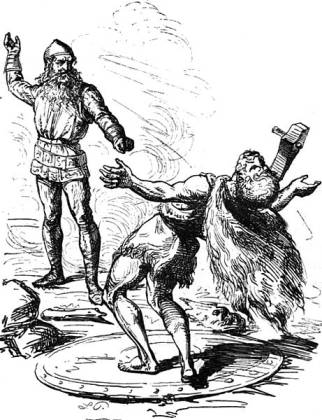
In the Skáldskaparmál (How to write as a skald), Mjölnir is mentioned several times in three different chapters. The first is in a chapter on kennings one can use for Thor. The second in a chapter about Thor’s duel with a jötun named Hrungnir. Finally, in the chapter where the creation story of Mjölnir and several of the treasures of the gods are made.
I am including only the chapter heading and a choice paragraph from that chapter below. IF you haven’t explored the Skáldskaparmál yet, reading just those chapters might be a great place to start.
IV – On how to paraphrase Thor
“What figures should be employed to periphrase the name of Thor? Thus: one should call him Son of Odin and of Jörd, Father of Magni and Módi and Thrúdr, Husband of Sif, Stepfather of Ullr, Wielder and Possessor of Mjöllnir and of the Girdle of Strength, and of Bilskirnir; Defender of Ásgard and of Midgard, Adversary and Slaver of Giants and Troll-Women, Smiter of Hrungnir, of Geirrödr and of Thrívaldi, Master of Thjálfi and Röskva, Foe of the Midgard Serpent. Fostered by Vingnir and Hlóra.
XVII – Haustlöng and Thor’s Duel with Hrungnir
Thor’s hammer Mjöllnir struck Hrungnir in the middle of the head, and smashed his skull into small crumbs, and he fell forward upon Thor, so that his foot lay over Thor’s neck. Thjálfi struck at Mökkurkálfi, and he fell with little glory.
XXXV – The treasures of the gods
Then he gave the hammer to Thor, and said that Thor might smite as hard as he desired, whatsoever might be before him, and the hammer would not fail; and if he threw it at anything, it would never miss, and never fly so far as not to return to his hand; and if be desired, he might keep it in his sark, it was so small; but indeed it was a flaw in the hammer that the fore-haft was somewhat short.
Gylfaginning – The Fooling of Gylfi
The other main part of the Prose Edda is the Gylfaginning, or the Fooling of Gylfi. Gylfaginning is cast in the form of a dialogue, it describes the visit of Gylfi, a king of the Swedes, to Asgard. In answer to his questions, the gods tell Gylfi the Norse myths about the beginning of the world, the adventures of the gods, and the fate in store for all in the Ragnarök. The tales are told with dramatic artistry, humor, and charm.
In chapter fourteen, we learn how Thor is able to resurrect his goats by holding Mjölnir over the pile of their skins and bones. Then in chapter fifteen Snorri tells about the death of Balder, and how Thor blesses his funeral pyre with Mjölnir. True to form, he also kicks a dwarf who irritates him onto the flaming boat, joining Balder in the afterlife. Finally, obviously inspired by the Vafthrudnismol, chapter seventeen relates how Magni and Modi will inherit their fathers hammer.
CHAPTER XIV. Thor’s Adventures
Thjalfe, the bonde’s son, had the thigh of one of the goats, which he broke asunder with his knife, in order to get at the marrow, Thor remained there over night. In the morning, just before daybreak, he arose, dressed himself, took the hammer Mjolner, lifted it and hallowed the goat-skins.
*comment: Since Thjalfe broke the goat’s bone to eat the marrow (tricked to do so by Loki) the goat is resurrected, but is lame. As payment, Thor takes both Thjalfe and his sister Roskva as indentured servants.
CHAPTER XV. The Death of Balder
51. Balder’s corpse was borne out on the ship; and when his wife, Nanna, daughter of Nep, saw this, her heart was broken with grief and she died. She was borne to the funeral-pile and cast on the fire. Thor stood by and hallowed the pile with Mjolner. Before his feet ran a dwarf, whose name is Lit. Him Thor kicked with his foot and dashed him into the fire, and he, too, was burned.
CHAPTER XVII. Regeneration
58. Then said Ganglere: Do any gods live then? Is there any earth or heaven? Har answered: The earth rises again from the sea, and is green and fair. The fields unsown produce their harvests. Vidar and Vale live. Neither the sea nor Surfs fire has harmed them, and they dwell on the plains of Ida, where Asgard was before. Thither come also the sons of Thor, Mode and Magne, and they have Mjolner. Then come Balder and Hoder from Hel. They all sit together and talk about the things that happened aforetime,—about the Midgard-serpent and the Fenris-wolf. They find in the grass those golden tables which the Aesir once had.
Mjölnir Symbolism and Use in the Viking Age
Not just a mythological artifact, there have been found a great number of small Mjölnir pendants from the Viking Age all across Scandinavia. Much more so than Odin, it was actually Thor who was the ‘peoples god’, or at least for the men. Women might have felt closer to Freyja, Frigg or possibly Eir, but for the ordinary man, Thor was most popular.
Odin was viewed as a scheming god, and more the god for the nobility and warring chieftains. Thor on the other hand was the protector of Midgard and all its people. He was seen as protecting them from threats from both monsters and jotnar.
I have seen quite a few of these pendants in various museums and while they vary somewhat in style, they typically have some common themes. The handle is usually short, and the head of the hammer is double, and rather snub. Many are quite plain, but some have really intricate patterns and decor, obviously having been a treasured and expensive artifact.
For the vikingr, or any ordinary man in the Viking Age, it was likely meant to protect the one who wore it. Maybe it was believed it would also give courage or strength, signaling that the wearer was ‘Thor’s man’.
Frequently Asked Questions
When I was looking around online to find the most common questions about Mjölnir I quickly realized that they are mostly based on the Marvel movies. In the MCU there are many great creative liberties taken with regards to its depiction of Norse mythology, Mjölnir is no exception. I will cover a few of them that are sort of general as well, but skip most.
Anyone could lift Thor’s mighty hammer. The idea that no one but Thor (or Captain America) could lift it is an MCU invention.
Actually the Anglicised name is pretty true to the original Old Norse which was Mjǫllnir.
It was made by the dwarven master craftsman Sindri and his brother Brokkr.
Thor’s two sons Magni and Modi survive Ragnarök and the two of them together inherits their fathers mighty hammer.


With regard to the origin of the name of Mjolnir, I was looking up the meaning of Menhir, used for standing stones in Britain, and thought it similar to Mjolnir so did a quick search, which lead
Me here 🙂 Although the archaeologist like to attribute Menhir as French, specifically Breton, seems more likely to me given British history and origins that it is Norse. Also Breton is an area referred to as the North men. It’s also attributed to Welsh and Cornish languages that are known to contain about 50% of the Breton Language. Much of the the original English has been absorbed into many of the invaders languages, but our traditions and local place names retain the old words.
Mjol is grind or mill,
Nir is stone. It’s a mill stone, possibly made from a mill stone, which would be very hard stone. But which mill stone? Likely one of legend.
My search began out of interest in the kingstones which have been assigned to “myth”. But were used throughout Britain to declare the rightful king and bear witness to their oath. Also this tradition is found in Egypt and Middle East which is the origin of the stone of scone, once known as Jacobs Pillow and originally the stone of witness of the gods when declaring their kings . The Romans are said to have prevented their use by the Britons, the London Stone being the most famous which they built around so it could not be accessed to declare rightful kings. It is still there, or may be? They moved it, there is a stone now lodged outside of a building but it may not be the original. The stone of scone they also copied as it does what it is stated to do it declares the rightful king, but will also denounce an unrighteous king.
I read a while back looking at the etymology of a word that now escapes me, that the particular word had its origins in Norse as an oath stone, a stone used to declare and bear witness to the rightful king. There are also stones in Ireland if the same legend. Which Norse stones are reputed to declare and bear witness to kings?
The stones of our history have power, they were not used just for decoration.
Why would the hammer be used to bless a marriage or sanctify a funeral? It is a sacred stone, a mill stone, used for nourishment, life, blessing’s, abundance. If Mjol also means white, snow, this indicates purity, sacred and spirit. A double meaning possibly?
Hi Freya, love your reflections on the origins and obvious hidden/lost deeper meaning of Mjölnir. I know they swore oaths on rings (arm rings) and might envoke Tyr or Ullr, but the hammer of Thor was seen as having special powers.
There is another fascinating tale of a millstone, churning out anything one might wish for, you might enjoy it 🙂 Check it out here: https://vikingr.org/old-norse-texts/lay-of-grotti
Br,
Marius